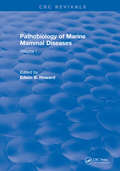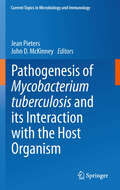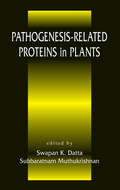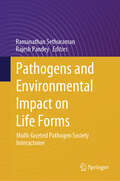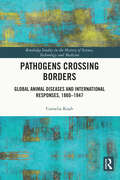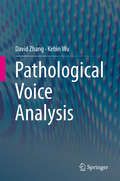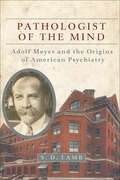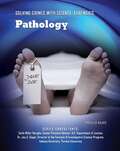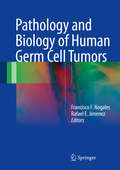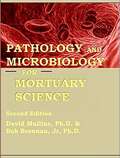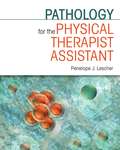- Table View
- List View
Pathobiology Of Marine Mammal Diseases: Volume II
by Edwin B. HowardThese volumes provide information which will be helpful to comparative pathologists, veterinarians, and all marine scientists and other individuals who are interested in the study of marine mammals, and the diseases they develop in both their feral and captive environment.This publication is a reflection of the observations of the various authors, some of whom have pioneered in this field, and is an attempt to update the available information concerning the natural diseases, and the corresponding pathologic changes in marine mammals.
Pathogen removal in aerobic granular sludge treatment systems (IHE Delft PhD Thesis Series)
by Mary Luz Barrios HernàndezThis book describes pathogen removal processes in aerobic granular sludge (AGS) wastewater treatment systems. Faecal indicators (E. coli, Enterococci, coliforms and bacteriophages) were tracked in full-scale AGS facilities and compared to parallel activated sludge (CAS) systems. AGS showed similar removals as the more complex CAS configurations. Removal mechanisms investigated in laboratory-scale reactors showed that the AGS morphology contributes to the removal processes. By tracking E. coli and MS2, it was observed that organisms not attached to the granules are predated by protozoa during aeration. 18S RNA gene analyses confirmed the occurrence of bacterivorous organisms (e.g., Epistylis, Vorticella, Rhogostoma) in the system. Particulate material in the feeding stimulated their development, and a protozoa bloom arose when co-treating with (synthetic) faecal sludge (4 % v/v). An overview of the diverse eukaryotic community in laboratory reactors and real-life applications is also provided. The microbial diversity of the influent was different compared to AGS and CAS sludge samples. However, no clear differences were found between them on species level. This study contributes to a better understanding of the mechanisms behind pathogen removals in AGS systems.
Pathogenesis of Mycobacterium tuberculosis and its Interaction with the Host Organism
by Jean Pieters John D. MckinneyMycobacterium tuberculosis is one of the most notorious pathogens on earth, causing the death of approximately 1. 5 million people annually. A major problem in the fight against tuberculosis is the emergence of strains that have acquired resistance to all available antibiotics. One key to the success of M. tuberculosis as a pathogen is its ability to circumvent host immune responses at different levels. This is not only a result of the special makeup of M. tuberculosis in terms of genetic diversity and DNA metabolism and its possession of specialized secretion systems, but also of its ability to hijack the host's innate immune defence mechanisms. In this volume, researchers from different disciplines provide a topical overview of the diverse mechanisms that contribute to the virulence of M. tuberculosis, ranging from their genetic, metabolic and molecular makeup, as well as the complex strategies these bacteria utilize to escape immune destruction within infected hosts.
Pathogenesis of Systemic Lupus Erythematosus: Insights from Translational Research
by Alberta HoiThe scope of this contributed volume is to provide an overview of the latest translational research in the field of lupus pathogenesis, with particular emphasis on how these discoveries progress in parallel with therapeutic drug development. Systemic lupus erythematosus (SLE) is a multifaceted disease with a number of well-defined immune pathways that are dysregulated, resulting in an immune-mediated chronic inflammatory injury at target organs. As knowledge of these pathways evolves to provide opportunities for targeted drug therapy and lays the foundation for personalized medicine, clinicians and researchers need to keep up with the ever-expanding medical literature.This book will critically appraise the current understanding of important immunological pathways that contribute to the pathogenesis of lupus. We will review the role of interferons as part of the innate immune defects that perpetuate the loss of self-tolerance in SLE. B cell hyperactivity, as a defining hallmark of SLE, and different strategies of B cell targeted therapy will be discussed. The role of co-stimulation or immune checkpoint molecules in activating B and T cells will be reviewed, as well as other cytokines that serve in the amplification loop promoting a more proinflammatory Th1 or Th17 responses. Intracellular targets, such as signaling molecules in the JAK/STAT pathway, or a variety of kinases and proteasomes, can cause a cascading downstream effect of transcriptional responses that are important in SLE. Immune homeostasis can also be restored by bolstering the naturally occurring anti-inflammatory mechanisms. Glucocorticoid, as a potent natural anti-inflammatory hormone, can mediate its effects by recruiting histone deacetylase that serve to repress gene transcription. Glucocorticoid-induced leucine zipper is a gene upregulated by glucocorticoid that can be a potential target for development of anti-inflammatory strategy. Finally, T regulatory cells can be utilized to help restore to immune tolerance and are amongst the latest focus of therapeutic development in SLE.
Pathogenesis-Related Proteins in Plants
by Swapan K. Datta Subbaratnam MuthukrishnanA great deal of research has been focused on the isolation, characterization, and regulation of expression of pathogenesis-related proteins since the discovery that several of the PR-proteins had antimicrobial or insecticidal activity and can delay the progression of diseases caused by several pathogens belonging to diverse genera. This is an excit
Pathogenic Fungi in Humans and Animals
by Dexter H. HowardExploring breakthroughs in fungal detection and control, this book covers fungal nomenclature, population instability, and phylogeny, as well as investigative research on Peronosporomycetes, Zygomycetes, Filamentous Ascomycetes, Basidiomycetous Yeasts, Endomycetes and Blastomycetes, and Miscellaneous Opportunistic Fungi. It offers methods to identi
Pathogenic Yeasts
by Ruth Ashbee Elaine M. BignellMycological studies of yeasts are entering a new phase, with the sequencing of multiple fungal genomes informing our understanding of their ability to cause disease and interact with the host. At the same time, the ongoing use of traditional methods in many clinical mycology laboratories continues to provide information for the diagnosis and treatment of patients. This volume reviews various aspects of pathogenic yeasts and what is known about their molecular and cellular biology and virulence, in addition to looking at clinical and laboratory findings. As each chapter is written by a leading expert in the field, this book summarizes in one volume much of the latest research on several pathogenic yeasts, including Candida, Cryptococcus, Malassezia and yeasts of emerging importance. The importance of laboratory diagnosis, antifungal susceptibility testing, antifungal resistance and yeast diseases in animals are reviewed.
Pathogenic Yersinia: Methods and Protocols (Methods in Molecular Biology #2010)
by Viveka Vadyvaloo Matthew B. LawrenzThis volume delivers a compendium of detailed protocols to the research community in order to aid in the investigation and discovery of Yersinia virulence mechanisms using important in vivo and in vitro infection models, which have led to major advances in the field and in our understanding of Yersinia pathogen-host interactions. Beginning with a section on mouse models, the book continues with chapters covering the monitoring of bacteria during infection, invertebrate models, as well as Yersinia interaction with immune cells and immune signaling. Written for the highly successful Methods in Molecular Biology series, chapters include introductions to their respective topics, lists of the necessary materials and reagents, step-by-step, readily reproducible protocols, and tips on troubleshooting and avoiding known pitfalls. Comprehensive and authoritative, Pathogenic Yersinia: Methods and Protocols provides a single source for researchers seeking to better understand these pathogens and the diseases they produce in humans.
Pathogenicity and Drug Resistance of Human Pathogens: Mechanisms and Novel Approaches
by Saif Hameed Zeeshan FatimaThe book comprehensively discusses the mechanisms of pathogenesis and drug resistance; current diagnostics landscape of four key human pathogens; bacterial, fungal, protozoans and viral which are the causes of major infectious diseases. It also assesses the emerging technologies for the detection and quantification of these pathogens. Further, it discusses the novel opportunities to fight against these infectious diseases and to identify pertinent drug targets with novel methodologies. It also reviews the current and future insights into the control, elimination, and eradication of these infectious diseases. Importantly, the book discusses the epidemiological characteristics and various challenges in combating Ebola and Influenza diseases. Finally, the book highlights the growing role of nanotechnology and bioinformatics resources for combating the infectious diseases. In summary, the book provides the mechanistic insight of the pathogenicity, drug-resistance, therapeutic strategies and identification of the novel drug targets of Mycobacterium tuberculosis, Plasmodium, Candida, Hepatitis C and emerging viral infections.
Pathogens and Environmental Impact on Life Forms: Understanding Pathogens and Host Defence Mechanisms
by Rajesh Pandey Ramanathan SethuramanSince before the time of our last common ancestor, microbes have been shaping our evolution and our environment, just as we have shaped theirs. This fact has recently gained renewed prominence with wider acknowledgement of the microbiome (part of One Health) and its role in maintenance of human homeostasis. This two-part book titled “Pathogens and Environmental Impact on Life Forms”, highlights the fluid dynamics we share with the microbes within us, including both, arguably ‘helpful’ species, and undoubtedly pathogenic ones (pathogen containment, clearance, and optimisation are dwelt on).It also underscores the effects of anthropogenic changes on microbes external to us, and the consequences of the resultant environmental dysbiosis for our continued health and well-being. Prominent examples include indiscriminate industrialisation and urbanisation. Both of these forces, empowered by a culture of consumerism, have led to excessive pollution and several detrimental lifestyle changes, which have culminated in our present obesity crisis and diabetes ‘pandemic’. Finally, this book concludes by emphasising that the way forward for healthcare is not only to be cognizant of the eubiotic microbiome in its diagnoses and treatments, but also to use this tremendous resource to contend with the quickly transforming landscape of infectious diseases.
Pathogens and Environmental Impact on Life Forms: Multi-faceted Pathogen Society Interactome
by Ramanathan Sethuraman Rajesh PandeyThis book underscores the effects of anthropogenic changes on microbes external to us and the consequences of the resultant environmental dysbiosis for our continued health and well-being. Since before the time of our last common ancestor, microbes have been shaping our evolution and our environment, just as we have shaped theirs. This fact has recently gained renewed prominence with wider acknowledgement of the microbiome (part of One Health) and its role in maintenance of human homeostasis. This two-part book titled “Pathogens and Environmental Impact on Life Forms” highlights the fluid dynamics we share with the microbes within us, including both, arguably ‘helpful’ species, and undoubtedly pathogenic ones (pathogen containment, clearance, and optimisation are dwelt on). Prominent examples include indiscriminate industrialisation and urbanisation. Both of these forces, empowered by a culture of consumerism, have led to excessive pollution and several detrimental lifestyle changes, which have culminated in our present obesity crisis and diabetes ‘pandemic’. Finally, this book concludes by emphasising that the way forward for healthcare is not only to be cognizant of the eubiotic microbiome in its diagnoses and treatments, but also to use this tremendous resource to contend with the quickly transforming landscape of infectious diseases.
Pathogens Associated with the Development of Cancer in Humans: OMICs, Immunological, and Pathophysiological Studies
by Noé Velázquez-Márquez Genaro Alberto Paredes-Juárez Verónica Vallejo-RuizThis book examines the relationship between the different infectious agents, such as viruses, bacteria, protozoa, and fungi, in the development of cancer. It is divided into six sections, spanning a range of topics, including infectious agents, main bacterial agents, and eukaryotic microorganisms, and how they contribute to cancer. Chapters also explore the anti-tumor effect of microorganisms, how pathogens induce epigenetic changes that are associated with cancer, and nutritional management for the prevention and treatment of pathogen-associated cancer, from a nutrigenomics perspective. The studies included cover epidemiological and immunological data, different OMICs data in general, and data of pathogens associated with cancer. The book is rounded out with an analysis of the role of glycans and molecular evolution in the progression of cancer.
Pathogens Crossing Borders: Global Animal Diseases and International Responses, 1860–1947 (Routledge Studies in the History of Science, Technology and Medicine #45)
by Cornelia KnabThe increasing globalization of trade, travel and transport since the mid-19th century had unwelcome consequences – one of them was the spread of contagious animal diseases over greater distances in a shorter time than ever before. Borders and national control strategies proved to be insufficient to stop the pathogens. Not surprisingly, the issue of epizootics (epidemics of animals) was among the first topics to be addressed by international meetings from the 1860s onwards. Pathogens Crossing Borders explores the history of international efforts to contain and prevent the spread of animal diseases from the early 1860s to the years after the Second World War. As an innovative contribution to global history and the history of internationalism, the book investigates how disease experts, politicians and state authorities developed concepts, practices and institutional structures at the international level to tackle the spread of animal diseases across borders. By following their activities in dealing with a problem area which was – and is today – of enormous political, social, public health and economic relevance, the book reveals the historical challenges of finding common international responses to complex and pressing global issues for which there are no easy solutions.
Pathogens for War
by Donald H. AveryPathogens for War explores how Canada and its allies have attempted to deal with the threat of germ warfare, one of the most fearful weapons of mass destruction, since the Second World War. In addressing this subject, distinguished historian Donald Avery investigates the relationship between bioweapons, poison gas, and nuclear devices, as well as the connection between bioattacks and natural disease pandemics. Avery emphasizes the crucially important activities of Canadian biodefence scientists - beginning with Nobel Laureate Frederick Banting - at both the national level and through cooperative projects within the framework of an elaborate alliance system.Delving into history through a rich collection of declassified documents, Pathogens for War also devotes several chapters to the contemporary challenges of bioterrorism and disease pandemics from both national and international perspectives. As such, readers will not only learn about Canada's secret involvement with biological warfare, but will also gain new insights into current debates about the peril of bioweapons - one of today's greatest threats to world peace.
Pathological Realities: Essays on Disease, Experiments, and History (Forms of Living)
by Mirko GrmekMirko D. Grmek (1924-2000) is one of the most significant figures in the history of medicine, and has long been considered a pioneer of the field. The singular trajectory that took Grmek from Yugoslavia to the academic culture of post-war France placed him at the crossroads of different intellectual trends and made him an influential figure during the second half of the twentieth century. Yet, scholars have rarely attempted to articulate his distinctive vision of the history of science and medicine with all its tensions, contradictions, and ambiguities. This volume brings together and publishes for the first time in English a range of Grmek’s writings, providing a portrait of his entire career as a historian of science and an engaged intellectual figure. Pathological Realities pieces together Grmek’s scholarship that reveals the interconnections of diseases, societies, and medical theories.Straddling the sciences and the humanities, Grmek crafted significant new concepts and methods to engage with contemporary social problems such as wars, genocides and pandemics. Uniting some major strands of his published work that are still dispersed or simply unknown, this volume covers the deep epistemological changes in historical conceptions of disease as well as major advances within the life sciences and their historiography. Opening with a classic essay – “Preliminaries for a Historical Study of Diseases,” this volume introduces Grmek’s notions of “pathocenosis” and “emerging infections,” illustrating them with historical and contemporary cases. Pathological Realities also showcases Grmek’s pioneering approach to the history of science and medicine using laboratory notebooks as well as his original work on biological thought and the role of ideologies and myths in the history of science. The essays assembled here reveal Grmek’s significant influence and continued relevance for current research in the history of medicine and biology, medical humanities, science studies, and the philosophy of science.
Pathological Voice Analysis
by David Zhang Kebin WuWhile voice is widely used in speech recognition and speaker identification, its application in biomedical fields is much less common. This book systematically introduces the authors’ research on voice analysis for biomedical applications, particularly pathological voice analysis. Firstly, it reviews the field to highlight the biomedical value of voice. It then offers a comprehensive overview of the workflow and aspects of pathological voice analysis, including voice acquisition systems, voice pitch estimation methods, glottal closure instant detection, feature extraction and learning, and the multi-audio fusion approaches. Lastly, it discusses the experimental results that have shown the superiority of these techniques. This book is useful to researchers, professionals and postgraduate students working in fields such as speech signal processing, pattern recognition, and biomedical engineering. It is also a valuable resource for those involved in interdisciplinary research.
Pathologies of Calcium Channels
by Norbert Weiss Alexandra KoschakCalcium ions represent Mother Nature's 'ion-of-choice' for regulating fundamental physiological functions, as they initiate a new life at the time of fertilization and guide subsequent developmental and physiological functions of the human body. Calcium channels, which act as gated pathways for the movement of calcium ions across the membranes, play a central part in the initiation of calcium signals, and defects in calcium channel function have been found to result in a plethora of human diseases, referred to as the calcium channelopathies. Pathologies of Calcium Channels brings together leading international experts to discuss our current understanding of human diseases associated with the various calcium channels, from their molecular basis to potential future therapeutic targeting of calcium channels.
Pathologies of Motion: Historical Thinking in Medicine, Aesthetics, and Poetics (The Lewis Walpole Series in Eighteenth-Century Culture and History)
by Kevis GoodmanAn original study of late Enlightenment aesthetics, poetics, and environmental medicine as overlapping ways of comprehending the dislocations of historical existence lodged in the movements of bodies and minds This book studies later eighteenth-century medicine, aesthetics, and poetics as overlapping forms of knowledge increasingly concerned about the relationship between the geographical movements of persons displaced from home and the physiological or nervous &“motions&” within their bodies and minds. Looking beyond familiar narratives about medicine and art&’s shared therapeutic and harmonizing ideals, this book explores Enlightenment and Romantic-era aesthetics and poetics in relation to a central but less well known area of eighteenth-century environmental medicine: pathology. No mere system of diagnosis or classification, philosophical pathology was an art of interpretation, offering sophisticated ways of reading the multiple conditions and causes of disease, however absent from perception, in their palpable, embodied effects. For medical, anthropological, environmental, and literary authors alike, it helped to locate the dislocations of modern mobility when a full view of their causes and conditions remained imperfectly understood or still unfolding. Goodman traces the surprising afterlife of the period&’s exemplary but unexplained pathology of motion, medical nostalgia, within aesthetic theory and poetics, arguing that nostalgia persisted there not as a named condition but as a set of formal principles and practices, perturbing claims about the harmony, freedom, and free play of the mind.
The Pathologisation of Homosexuality in Fascist Italy: The Case of 'G' (Genders and Sexualities in History)
by Gabriella RomanoThis open access book investigates the pathologisation of homosexuality during the fascist regime in Italy through an analysis of the case of G., a man with "homosexual tendencies" interned in the Collegno mental health hospital in 1928. No systematic study exists on the possibility that Fascism used internment in an asylum as a tool of repression for LGBT people, as an alternative to confinement on an island, prison or home arrests. This research offers evidence that in some cases it did.The book highlights how the dictatorship operated in a low-key, shadowy and undetectable manner, bending pre-existing legislation. Its brutality was - and still is - difficult to prove. It also emphasises the ways in which existing stereotypes on homosexuality were reinforced by the regime propaganda in support of its so-called moralising campaign and how families, the police and the medical professionals joined forces in implementing this form of repression.
Pathologist of the Mind: Adolf Meyer and the Origins of American Psychiatry
by S. D. LambIlluminating the contributions of Adolf Meyer, the pioneering father of modern American psychiatry.Winner of the CHOICE Outstanding Academic Title of the Choice ACRLDuring the first half of the twentieth century, Adolf Meyer was the most authoritative and influential psychiatrist in the United States. In 1908, when the Johns Hopkins Hospital established the first American university clinic devoted to psychiatry—still a nascent medical specialty at the time—Meyer was selected to oversee the enterprise. The Henry Phipps Psychiatric Clinic opened in 1913, and Meyer served as psychiatrist-in-chief at Johns Hopkins until 1941. In Pathologist of the Mind, S. D. Lamb explores how Meyer used his powerful position to establish psychiatry as a clinical science that operated like the other specialties at the country’s foremost medical school and research hospital. In addition to successfully arguing for a scientific and biological approach to mental illness, Meyer held extraordinary sway over state policies regarding the certification of psychiatrists. He also trained hundreds of specialists who ultimately occupied leadership positions and made significant contributions in psychiatry, neurology, experimental psychology, social work, and public health. Although historians have long recognized Meyer’s authority, his concepts and methods have never before received a systematic historical analysis. Pathologist of the Mind aims to rediscover Meyerian psychiatry by eavesdropping on Meyer’s informal and intimate conversations with patients and colleagues. Weaving together private correspondence and uniquely detailed case histories, Lamb examines Meyer’s efforts to institute a clinical science of psychiatry in the United States—one that harmonized the expectations of scientific medicine with his concept of the person as a biological organism and mental illness as an adaptive failure. The first historian ever granted access to these exceptional medical records, Lamb offers a compelling new perspective on the integral but misunderstood legacy of Adolf Meyer.
Pathology (Solving Crimes With Science: Forensics #12)
by Maryalice Walker"Real-life" crime dramas on television intrigue us with the details of postmortem examinations leading to the arrest of murder suspects--but how do forensic pathologists, the doctors who investigate unnatural deaths and chilling crime scenes, actually bring criminals to justice? The story lies in the body of evidence. Literally. The human body provides a wealth of scientific evidence that allows forensic pathology, or legal medicine, to help resolve criminal cases and convict even most elusive perpetrators. The human body records the story of a crime in the language of cuts, wounds, and bruises, and in the fingerprints and bloodstains. Forensic pathologists are trained to scrutinize and interpret this evidence in ways no other scientist can. Examining victims' remains from the outside in, forensic pathologists investigate every inch of the human landscape to discover when, how, and why the victim died. Sometimes, a time of death is all a jury needs to convict a suspect of murder, and forensic pathologists are experts at uncovering this crucial evidence. Visiting crime scenes, collecting bodies in the middle of the night, and excavating suspicious burial grounds are all in a day's work for the sake of bringing justice to victims who can no longer speak for themselves.
Pathology and Biology of Human Germ Cell Tumors
by Francisco F. Nogales Rafael E. JimenezThis book provides, for the first time, a detailed, up-to-date, holistic approach to the pathology and biology of germ cell tumors. The main focus is the complex histopathology of these tumors, but special considerations are also given to their morphologic variations in relation to age, gender and organ. Critical updates are provided on terminology and classification; the discussion of biology and pathogenesis includes references to many molecular genetic and immunohistochemical findings from recent stem cell research. Individual chapters are devoted to germ cell tumors at different anatomic locations, including not only the ovaries and testes but also the mediastinum and central nervous system, and pediatric tumors. All of the contributing authors are opinion leaders from universities of excellence in Europe and the United States. This monograph will be of wide interest to practitioners and researchers in many fields of medicine, including pathology, gynecology, urology, and pediatrics, as well as stem cell scientists.
Pathology and Microbiology for Mortuary Science
by David F. Mullins Bob BrennanThis is a comprehensive book for the study of pathology and microbiology written for mortuary science students, as a resource for educators, and as a reference for funeral directors and embalmers. <p><p> The book is designed around the current American Board of Funeral Service Education's Curriculum Outlines for pathology and microbiology. Quick reference appendices provide a review of pertinent anatomy and physiology. Case studies in chapters that discuss specific diseases allow learners to review the postmortem condition of human remains in relation to the disease.
Pathology for the Physical Therapist Assistant
by Penelope J. LescherWith other texts written at either too high or too low a level, this book meets the needs of PTA students for usable, understandable pathology related to clinical application. Extensively illustrated, this book allows students to more easily comprehend and maintain interest in otherwise complicated pathological processes. The fourteen chapter format effectively fits within a chapter per week course structure, or each chapter may be used as a stand alone module within any course. And as your students prepare to graduate, encourage them to keep this book to use as a clinically relevant reference as practicing PTAs!
Pathology for Toxicologists: Principles and Practices of Laboratory Animal Pathology for Study Personnel
by Elizabeth McinnesNon-pathologists, such as toxicologists and study personnel, can find it difficult to understand the data they receive from pathologists. Toxicological pathologists write long, detailed and highly technical reports. Study personnel are under daily pressure to decide whether lesions described in pathology reports are treatment-related and thus important to the pharmaceutical company or whether the lesions are background changes and thus of little significance. Written by experienced toxicological pathologists, Pathology for Toxicologists: Principles and Practices of Laboratory Animal Pathology for Study Personnel serves to bridge the gap in the understanding of pathology data, enabling non-pathologists to more easily comprehend pathology reports, better integrate pathology data into final study reports and ask pathologists relevant questions about the test compound. This succinct, fully referenced, full colour book is suitable for toxicologists at all stages of their training or career who want to know more about the pathology encountered in laboratory animals used in safety studies. Key features include important chapters on spontaneous and target organ lesions in rats, mice, non-human primates, mini pigs, rabbits and beagle dogs as well as information on general pathology, macroscopic target organ lesions, ancillary pathology techniques, haematology, biochemistry and adversity. Pathology for Toxicologists: Principles and Practices of Laboratory Animal Pathology for Study Personnel includes: Colour diagrams explaining how lesions are caused by either external compounds or spontaneously The anatomic variations and background lesions of laboratory animals Advice on sampling tissues, necropsy, ancillary pathology techniques and recording data A chapter on the haematology and biochemistry of laboratory animals Full colour photographs of common macroscopic lesions encountered in laboratory animals A comprehensive glossary
